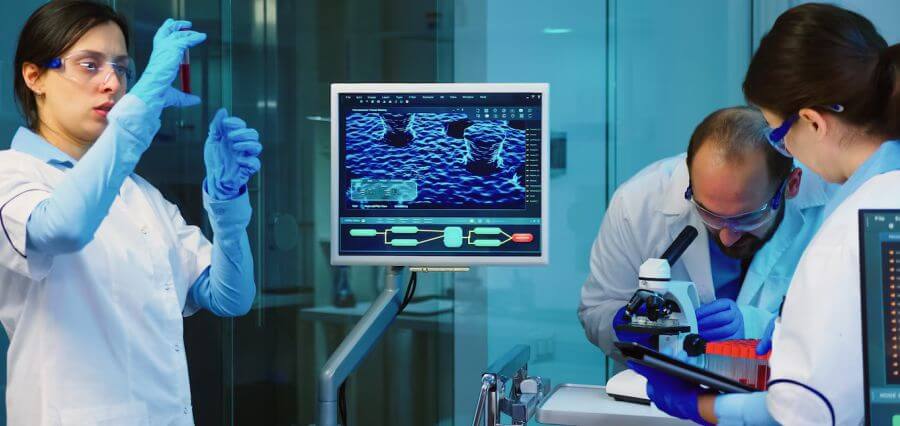According to the World Health Organization (WHO), cancer is currently one of the leading causes of mortality, responsible for approximately 10 million deaths in 2020. This means that roughly one in six deaths globally is due to cancer.
The urgent need for effective diagnostic methods and treatments led to the research of cancer biomarkers, beginning in the 1960s when scientists identified carcinoembryonic antigen (CEA), serving as a biomarker for diagnosing colorectal cancer, and alpha-fetoprotein (AFP), a marker that helps detect germ cell tumors and liver cancer.
Decades after these initial discoveries, researchers have been continuing their search for new biomarkers to improve diagnostics precision, support early cancer detection, assist in personalized therapy selection, and monitor cancer proliferation and response to treatment. Read this article to explore present and future trends in cancer biomarker testing.
Next-Generation Sequencing
One of the powerful techniques currently used for the analysis of alterations and genetic mutations in cancer cells is next-generation sequencing (NGS).
DNA sequencing is a method used to reveal the exact order of nucleotides — the DNA building blocks: adenine (A), thymine (T), cytosine (C), and guanine (G). The nucleotide sequence determines the growth and development of all living organisms and many viruses. It also influences their reproduction and can affect cancer risk.
Conventional sequencing methods were separately developed by Frederick Sanger and Walter Gilbert in 1977, followed by extensive research aimed at automating the process. The introduction of the “Method of nucleic acid amplification” by Eric Kawashima, Laurent Farinelli, and Pascal Mayer in the late 1990s marked another breakthrough, leading to the creation of NGS, a rapid, high-throughput, and cost-effective DNA sequencing method.
NGS is continually being developed, with researchers aiming to further reduce its cost, ultimately targeting the “$100 genome,” mainly through increased automation. The limits of the number of sequences NGS can handle simultaneously are also expected to expand.
Future cancer biomarker research is anticipated to benefit from single-cell sequencing due to its enhanced precision. This method allows researchers to observe the unique genetic makeup of individual cells and study cellular diversity, which is crucial for understanding cancer.
Artificial Intelligence
Cancer biomarker research has already been leveraging machine learning algorithms to empower artificial intelligence. Unlike traditional algorithms that act as instructions for computers, machine learning algorithms allow for the analysis of data to identify patterns that are not apparent to humans.
For example, unsupervised machine learning techniques, which do not provide a computer with labeled outcomes, were utilized by researchers from Stanford University to differentiate subtypes of breast cancer by analyzing gene expression. By using clustering algorithms, specifically K-means clustering, which group data points based on detected similarities, scientists were able to identify distinct cancer subtypes based on their unique gene expression patterns.
This is just one example of machine learning applications in cancer biomarker research. These techniques are continually optimized to help researchers create risk models for cancer using biomarker profiles and assist doctors in making effective treatment decisions. The NGS technology itself can be further enhanced by AI integration, making sequencing more efficient and accurate.
Liquid Biopsy
Cancer researchers are particularly interested in discovering and studying biomarkers present in body fluids, especially blood, urine, and saliva, as they can be used for non-invasive liquid biopsy.
Liquid biopsy can greatly benefit cancer treatment and prevention by reducing the need for conventional biopsy, which, besides being costly, is associated with discomfort, pain, and health risks such as bleeding or infections. Consequently, liquid biopsy is a better solution for regular health assessments and treatment monitoring.
Thymidine kinase is one of the biomarkers present in blood serum with significant potential for evaluating the level of cancer proliferation in the body. One specific application of thymidine kinase is predicting and providing an early prognosis of the effectiveness of metastatic breast cancer (mBC or stage IV breast cancer) treatment in postmenopausal hormone receptor-positive (HR+) mBC patients.
In addition to enabling regular assessments of disease conditions due to the convenience and accessibility of liquid biopsy, thymidine kinase tests can offer particularly precise detection of changes in cancer proliferation. These tests can identify changes months before they become visible through imaging techniques.
The research of cancer biomarkers available in samples collected through liquid biopsy is expected to advance significantly with the evolution of NGS and AI technologies.
Final Thoughts
Cancer biomarker testing has significantly advanced our understanding of this debilitating disease, offering insights into the diversity of cancer subtypes, genetic risks, individual’s sensitivity and resistance to various treatments, and the precise status of the disease in patients.
Cancer biomarkers are anticipated to undergo extensive future research, focusing on the discovery of new substances that can assist doctors in diagnosing and treating tumors, particularly those available for collection through liquid biopsy. Additionally, significant efforts will be dedicated to conducting the necessary research on already identified promising markers to facilitate their clinical adoption.
NGS and AI remain crucial technologies supporting biomarker testing research.
Read More: Click Here










